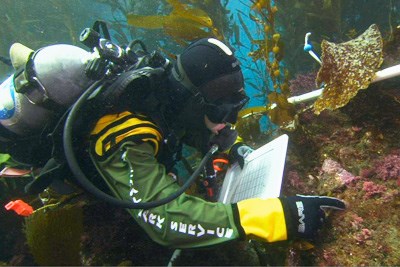
Brett Seymour The ocean environment within Channel Islands National Park encompasses rocky reefs with towering kelp forests that support over 1,000 marine species, seagrass beds that act as nursery grounds for numerous fish and invertebrate species. Adjacent deep submarine canyons and towering pinnacles attract unique assemblages of species in search of food and shelter. The park waters also help sustain a wide variety of seabirds and shorebirds that rarely occur together such as black oystercatchers from the north and American oystercatchers from the south. These, and several other northern and southern species, nest on the islands. 
Jessica Weinberg McClosky / NPS The living marine resources in Channel Islands National Park are managed by the State of California’s Department of Fish and Wildlife. The State’s jurisdiction includes the three nautical miles of water around each island. These same waters out to six nautical miles around each island form the Channel Islands National Marine Sanctuary. The National Park Service, State of California, and National Marine Sanctuary work closely together to preserve and protect the marine resources at the Channel Islands. 

NPS Channel Islands National Park’s Kelp Forest Monitoring Program collects information on the status of the marine life in the park and marine reserves to help the California Department of Fish and Wildlife to better understand and protect its marine resources. Closer to shore, the park’s Rocky Intertidal Monitoring Program collects data on additional marine species found in rocky intertidal habitats. Both programs began in the early 1980s and represent some of the oldest and largest datasets in the National Park Service and the world.
Pacific Ocean Education Team (POET) Newsletters POET is a team of National Park Service employees and partners committed to educating the public about the resource that is our Pacific Ocean. Below are newsletters that have been produced as part of that outreach effort. |
Last updated: December 28, 2017
